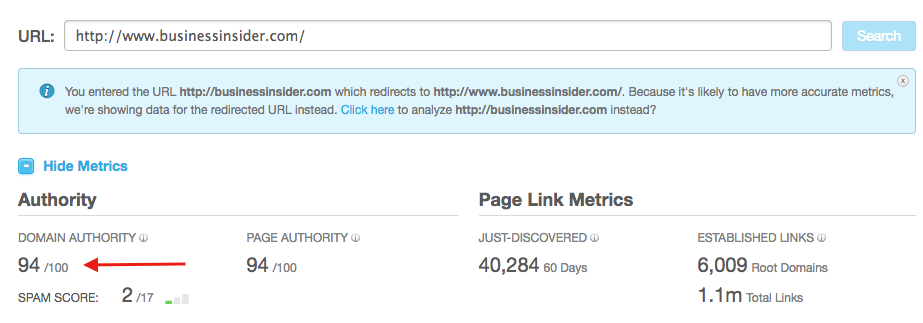How to Get Your First DA 80+ Backlink. But anyone can get a backlink. Enter a URL and click “Search.” On the results page, you can see the site’s DA ranking on the left side of the first box: If the score is 80 or higher, prioritize that site. First, find broken links on high authority sites. You’ll see a list of all the dead links on that page or site and to see which pages on the site have these broken links, click on any URL and click the “Inlinks” tab at the bottom of the screen. Authority sites want content that is perfect for their readers, so custom content will usually have an edge over existing content. But contextual links are way better than author bio links. Contextual links are great because readers are more likely to click a contextual link than an author bio link. And in case you were wondering, Clicky has a DA of 83: So a well-written testimonial could land you on a high DA site. How are you going to get an authority backlink?

Many businesses frame and hang up the first dollar bill they ever earned.
It’s a reminder that they were able to overcome the initial hurdles of opening a business.
For webmasters building a link strategy, their first authority backlink is the equivalent of that first dollar earned.
But anyone can get a backlink. Heck, you can even buy backlinks (although I strongly advise against buying links).
So a random backlink isn’t really anything special.
But if you get a backlink from a site with a high Domain Authority ranking, then that’s something to tell everyone about.
In most cases, though, a high-quality backlink is worth way more than a buck. Some businesses pay thousands of dollars to get a single DA 80+ backlink.
Domain Authority (DA) is one of the most important metrics when it comes to websites. Developed by Moz, the DA is a reflection of how popular and trustworthy a site is.
The higher the DA, the better the link.
While there’s no official range for “good” or “bad” DA rankings, it’s widely accepted that sites with a score of 80 or higher are in the big leagues.
We’re talking sites like the NYtimes.com, HuffingtonPost.com, and Time.com.
If you earn a backlink from one of these authority sites, you’ll get a ton of benefits.
Your own site’s DA will go up, your SEO will improve, and you’ll get more traffic.
But getting backlinks from big authority sites is much easier said than done.
I’ve seen people try their absolute hardest to get high-DA backlinks, but they ultimately fail.
If you haven’t been able to get an authority backlink, don’t worry. It’s not your fault.
Many people don’t know how to score a backlink from these sites, but once you know what to do, it becomes much easier.
I’m going to share my strategies for getting authority links. These techniques are repeatable and scalable, and you can use them no matter how little your site may be.
Which sites should you target?
Before you use any of these methods, you need to determine which sites to go after.
You don’t want to chase every site in your niche with a DA of 80 or higher. If you get more specific with your targeting, you’ll have a much higher chance of landing backlinks.
I recommend starting by getting a sense of which sites in your niche are getting the most attention.
A simple Google search often works. Start by searching for your focus keyword.

As a general rule of thumb, any result on the first page likely has a high DA. This isn’t always the case, but it’s true most of the time.
Make a list of all of the domains on page 1 of Google. You can then check their DA using Moz’s Open Site Explorer.

Enter a URL and click “Search.” On the results page, you can see the site’s DA ranking on the left side of the first box:

If the score is 80 or higher, prioritize that site. You’re aiming for the best of the best here.
If you target too many sites at one time, it can be overwhelming. I suggest targeting 5-7 sites to start out with.
Now that you’ve found your target sites, you’re ready to use some backlink strategies.

Fixing broken links
You may have heard about this method before. (Even if you have, keep reading.)
The basic idea is that most sites have at least a handful of links that no longer work.

Usually, broken links lead to pages that were deleted a long time ago.
Now think about this in context.
If you owned a huge website, wouldn’t you want to ensure your users were able to access everything, including all of your backlinks? Of course, you would!

But there’s even more at stake.
Let’s say you cite a study to back up a crucial point. When your users click on the link to the study, they get a 404.
Bad for users. Bad for your site.
This can cause your credibility to take a dive, and you may even lose readers.
Can you see why broken links are so bad?
Even though you may not own a high-authority site like Forbes, you can still use this information to your advantage.
If you find a broken link on a site with a high DA score, you can use that opportunity to help the site and dramatically increase your chances of getting a backlink.
How do you do this? You tell the site about the broken link and offer your own content to replace it.
You also simply ask for a backlink in return for the help.

Obviously, you’re going to need some rock-solid content on your website in order to qualify for that link.
It’s not a complicated strategy, but it’s tried and true. You can use it to build your SEO while positioning your own site as an authority.
Interested? Here’s how to do it.
First, find broken links on high authority sites. You can use the Screaming Frog SEO Spider (one of my favorite SEO tools) to do this.
First, download the tool here.
Next, enter the URL into the box at the top of the tool and hit “Start.”
I recommend finding the URLs of older articles. If you crawl the entire site, you’ll have a lot of links to sort through, and that could take a while.

The SEO Spider will crawl the website and get all of the data ready.
When the tool is finished crawling the site, click on the Response Codes tab (fourth from the left).
Then head to the sidebar on the right side and scroll down until you see the “Client Error (4xx)” tree. Click on that.
You’ll see a list of all the dead links on that page or site and to see which pages on the site have these broken links, click on any URL and click the “Inlinks” tab at the bottom of the screen.

The URL in the “from” column is the page on the site that contains the broken link. That’s the URL you’ll want to reference when contacting the site.
If it’s more convenient for you, you can also export all of this data to a spreadsheet.
Our example broken link will be from this Business Insider article. Business Insider has a DA of…

COMMENTS